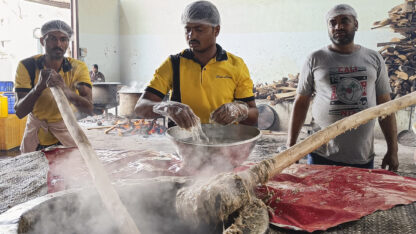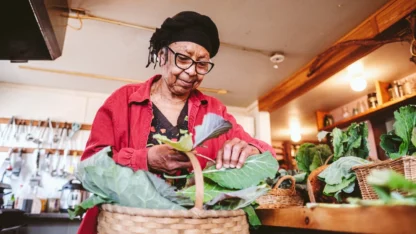Food writer and chef Eric Kim has been called a “triple threat: a great writer, elegant innovator and sublime aesthete” by the author Min Jin Lee. You may know Eric Kim from his popular videos on the New York Times Cooking YouTube channel. He’s a New York Times staff writer and also writes a monthly column for the New York Times Magazine. Kim also takes pride in being born and raised here in Atlanta. He has a new cookbook, “Korean American: Food that Tastes Like Home,” and he joined “City Lights” host Lois Reitzes via Zoom to talk about his new collection of recipes and family stories.
Interview highlights:
Comfort food in comfy settings:
“My mother and I … we love television, and more specifically, we love eating food in bed, in front of the television. Like, my parents have always — I’m going to embarrass them, but I don’t know if it’s a Korean thing or maybe other people have this too — but their bedroom just always had the biggest TV in the house,” said Kim. “So they retire not to the couch but to their bed. And over Christmas, we joined them, not just in the bed, but like, lying around the bed. My brother, his wife, all the dogs, we’d watch movies in that bedroom.”
“I think there’s no greater pleasure … I highly recommend it. It is messy, though. It’s dangerous. You’re going to get gochujang butter on your sheets, but you can just wash it.”
The joy of sharing new flavors:
“Doenjang is fermented soybean paste,” Kim explained. “It’s sort of like the sister to gochujang, and I think it’s really important. I think it’s so delicious, and I just want more people to know about it, but instead of feeding someone a doenjang stew, first what I’ll do is I’ll put some doenjang on a spoon and drizzle some honey over it. Because I think doenjang is at its zenith when you have it paired with a glossy sweet thing. And that bite makes people just … it makes their eyes open up. They’re like, ‘Whoa.’”
“It’s kind of like introducing someone to a brand new taste, and what a joy, right? One of the reasons I eat at restaurants is so I can taste something brand new, and that’s really exciting to me when a chef can accomplish that. Because I’ve eaten a lot in my life.”
Reinventing dishes born out of wartime hardship:
“There’s a dish in the book called budae jjigae, and it’s truly, that is actually a product of the [Korean] War, where army rations are used to create the stew, and so people in my grandmother’s generation aren’t so proud to see that, or they’re like, ‘Why are you showing that? It’s a blot in our country’s history,’” Kim said. “But I love the way in which Koreans have reclaimed dishes like that, and well, the irony now is that budae jjigae costs like 50 bucks at a restaurant; it’s so expensive.”
“I think of it as kimchi jjigae and ramen, times nine, because then you add the Spam, and you add the sausages. I like to make mine with kielbasa and Italian sausage and breakfast sausage, and it’s just a real hodgepodge of all your favorite processed meats,” Kim went on. “The meaning of that dish, and the meaning of the Korean War and Spam, and all of these resonances of history, they evolve, and they evolve as a nation heals and as we work through trauma. And I think it’s also very Korean to accept the pain with the pleasure.”
Eric Kim’s new cookbook “Korean American: Food that Tastes Like Home” is available to purchase through the author’s website at erickim.net/cookbook.









